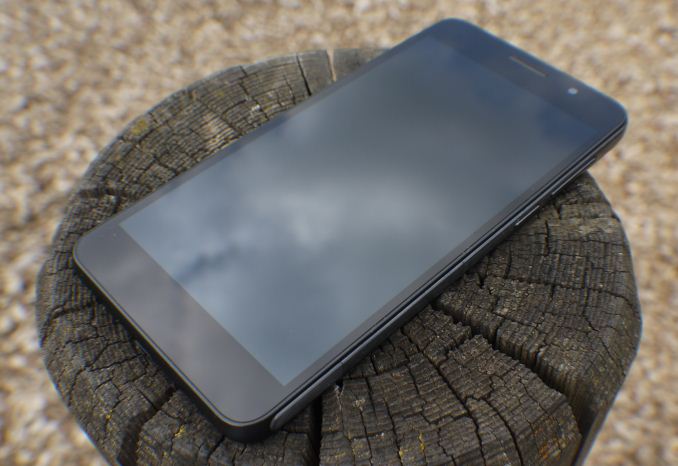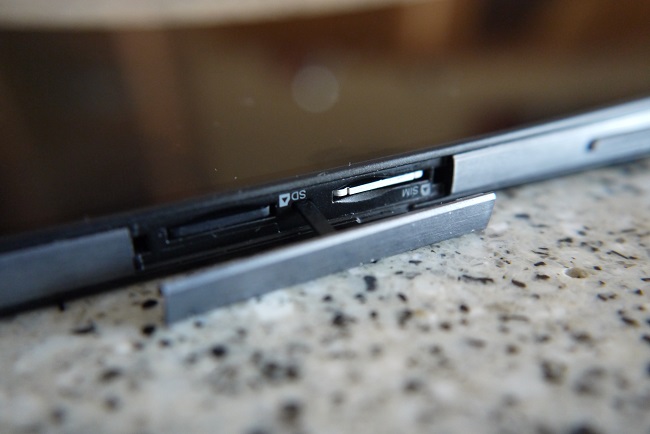Huawei Honor 6 Review
by Andrei Frumusanu & Joshua Ho on September 12, 2014 9:00 AM EST- Posted in
- Smartphones
- Huawei
- Android
- Mobile
- Honor 6

While Huawei's flagship banner was traditionally carried by its Ascend P-series, the P7 didn't ship with a high end SoC that was able to compete with other devices in the same category. With the Honor 6, Huawei takes a departure from its usual lineup and introduces their first big.LITTLE and high-performance SoC, the HiSilicon Kirin 920, which will be a key area of examination.
The Honor 6 sports the same 5" form factor as its cousin the Ascend P7, but with different build materials and design. We take a in-depth look into how this new player competes in terms of performance and power consumption.
Hardware
| Huawei Honor 6 Specifications | |
| SoC | HiSilicon "Kirin 920" Hi3630 (4x A7 @ 1.3GHz & 4x A15 @ 1.7GHz, Mali T628MP4 @ 600MHz) |
| RAM/NAND | 3 GB LPDDR3-1600, 16/32GB NAND + microSD |
| Display | 5” 1920x1080 JDI In-cell |
| Network | HiSilicon Balong LTE Cat. 6 300Mbps CA modem (SoC integrated) |
| Dimensions | 139.6 x 69.7 x 7.5mm, 130 grams |
| Camera | 13MP Sony BSI sensor, F2.0 aperture, ISP 5-piece lens 5MP front camera |
| Battery |
3000 mAh (11.4 Wh) rated |
| OS | Android 4.4.2 "EmotionUI 2.3" 3.10.33 Linux Kernel |
| Connectivity | 802.11a/b/g/n Wifi + BT 4.0, USB2.0, GPS/GLONASS, FM radio |
| SIM Size | MicroSIM |
| Price | $389.90 |
We start by taking a look at the design which is quite modest. The front face is minimalistic and sports few features that would make it possible to distinguish what phone it is. The lack of Huawei's logo on the front is intriguing as it doesn't appear on the back either. In fact, there is no way to tell that this is a Huawei phone at all as their name is nowhere to be found, with only the "Honor" logo adorning the top-middle on the back of the phone. I see this as a plus, as it contrasts with other phones that have manufacturer logos on both sides of the phone. However, I see how this could lead to confusion amongst average consumers that wouldn't recognize a phone by its design.
The general design reminds me of Sony's original Xperia Z, as both feature glossy back-panels and shiny plastic rims that contrast with the rest of the phone. This also comes with the same disadvantages that we saw on Sony's devices; the back is very fingerprint prone and slippery. The device comes with an oleophobic layer which makes it easy to wipe off the smudges, but once that eventually wears off after several months of use, I'm not keen on having to deal with this problem. It's worth mentioning that the back panel is neither glass nor scratch resistant and is easily damaged. I've already managed to inadvertedly mark this unit with some small scratches in daily use. Because the device's back is perfectly flat and has no protruding parts, I caught the device more than once sliding away from where I put it if it wasn't on a perfectly even or grippy surface. The side bezels also are extremely slippery - during normal use I found this impractical as it reduces the my grip on the device. I don't see why they couldn't have stuck with the matte plastic finish that is found only on the bottom of the device and used that for all sides.
In terms of external features, we have a standard microUSB 2.0 socket at the bottom of the device, power and volume rocker on the right hand edge in a comfortable position, and at the top a 3.5mm headphone jack and IR blaster. We find dual-microphones at the top and bottom. Because the back cover is non-removable (and thus making the battery non-replaceable), the microSIM and microSD card slots are tucked away under a panel on the bottom right side of the phone. I found the panel to be relatively sturdy and snug when closed, so it's not noticeable unless you look for it. The power and volume rocker buttons are clicky and sturdy, no complaints there.
On the back we find the camera lens on the top right of the phone, similar to iPhones and Sony's devices. As mentioned earlier, the piece doesn't protrude and seems to be well-protected from scratches. Next to it is a dual-LED flash setup, however it's just two identical LEDs working in tandem. Nevertheless, I was fairly impressed with the brightness, wide and even spread of light they were able to output. It's definitely the brightest torchlight I've found to discover on a smartphone.
The Honor 6 comes in 4 variations: the TDD-LTE model which has incompatible frequencies to operate in the western markets beyond basic 2G connectivity (H60-L01), and the FDD-LTE model which does feature compatible bands, and also comes with dual-SIM capabilities (H60-L02). The two basic 16GB network versions come in 32GB variants (H60-L11 for TDD, H60-L12 for FDD). The TDD version is aimed at the Chinese market, and will be the version we're reviewing as that is the unit Huawei has sent us. Unfortunately, this means we are unable to properly review the connectivity of the phone.
The launch price resides at $389.90 and undercuts most other flagships, a factor that should be definitely considered when evaluating the device.
Next, let's take a look at what Huawei offers in terms of software.


















59 Comments
View All Comments
DIYEyal - Saturday, September 13, 2014 - link
I found a typo in the battery life page: "I think this is due the phone having quite good thermal dissipation charateristics ."akshayprbhu - Friday, October 10, 2014 - link
that is not a typo. The phone is having good thermal dissipation as it is cooler than similar spec phones when a performance test was done! Youtube for more proof...lilmoe - Saturday, September 13, 2014 - link
Great review of what really matters. I especially liked the in-depth analysis of the SoC and its platform power in comparison to others. Looking forward to future reviews."Ideally, it would be interesting to see a 720p mode on 1440p screens as it would offer perfect scaling, with one logical pixel being mapped to exactly four physical ones, without the need for interpolation and upscaling artifacts"
If Samsung ever decides to put a 1440p panel on the GS6, I seriously hope they allow a 720p mode in their power saving options. Even if pentile, It would be MUCH sharper than any other 720p AMOLED panel since it's up-scaled. Actually, I seriously interested to see how it would look like. Plus, the added performance and battery life would be legendary on a phone faster and more efficient than the current GS5. Totally intriguing.
lilmoe - Saturday, September 13, 2014 - link
Oh, this is just a suggestion. If you must use browser benchmarks to measure platform performance (sighs...), wouldn't it be better to use the stock browser since it's what most people use? You know, since the stock browser is usually more optimized for that specific device and generally performs better than Chrome. Using Chrome to see the difference of Android devices in comparison is OK since they'd be using the same browser running on the same OS, but definitely NOT OK in comparison with other platforms.Please correct me if I'm wrong, because I'm positive that I'm not.
aryonoco - Sunday, September 14, 2014 - link
Thanks for the great review, this was the first time that any publication has exposed the inner workings of a Hisilicon SoC, and you've done a great job of that. However I wanted to mention here that I strongly disagree with your analysis of the software.Designing software that's going to be used by mass users is a constant balancing act between exposing enough power to satisfy different user requirements and power users, and yet keeping the UI simple enough so that the vast majority of users are not overwhelmed by the array of features. The Permission Management feature here, similar to those baked into many custom ROMs goes well over the line and is a huge user experience disaster. To ship an OEM ROM with this, is begging for a deluge of support calls from clueless customers who have disabled things and then wonder why their phone doesn't work as intended.
I'm not saying that the current permission management scenario in Android is perfect, far from it. I don't think anyone has figured out the perfect balance of how to inform users about third party apps without scaring them, turning the notices meaningless, or overwhelming users.
One of Anand's greatest assets was his ability to articulate his vision of good UI in various products. Him and Brian could explain why certain choices were made (for example in terms of treatment of external storage on Android, or the design tradeoffs about non-replaceable batteries) and the guiding principles behind them. File managers are archaic and confusing to 90% of users. I know the tech-savvy AT readership will disagree, but the whole concept of files and directories are broken for average users, especially on a device like a phone, and they are better off being abstracted away from them. Your comments on file managers in KitKat, or your praise of Huawei's software "enhancements" shows a lack of understanding of where the line is when it comes to UX design.
I hope that now that Anand is gone, AT doesn't become a place where the writers are blind to the needs of average customers. We do not need Android to regress to the wild days of Gingerbread, or worse, Windows Mobile.
Ethos Evoss - Sunday, September 14, 2014 - link
Well, you complaining about huawei logo or writing missing and main thing is that you NEVER complained on iphones that they NEVER put writing on their phones but that is alright ? h ? people are so pathetic .. if apple wud make soome plastic dick sticking out from phone you guys would say that is fine bcos it is iphone and we will forgive that we will get used to it .. oohh jeezz naive peopleakshayprbhu - Friday, October 10, 2014 - link
the writings are a part of the mandatory regulations to denote the compliance with the telecom regulations. and it does not eat up too much space on the back.darkich - Sunday, September 14, 2014 - link
Absolutely great analysis. Andrei and Joshua, keep these top notch write ups coming!SeleniumGlow - Monday, September 15, 2014 - link
I was hoping that the Kirin processor would have a comparison with the MediaTek MT6592. But I guess there are some obvious differences in the Big Little implementation that will prevent it from being a good comparison.siberstorm - Monday, September 15, 2014 - link
The mediocre camera and obvious cutrate shoddiness (wtf the stabilization is just the 1080p field cut down to 720p with none of the rest of the sensor used, so ghetto) is unacceptable and this goes for the mate 7 as well. So bye bye huawei. I am still interested in the lenovo vibe z2 pro aka k920 and would love a review of that phone, but the chances of lenovo sending one to anandtech are slim, considering they arent gunning for the global market like huawei is.